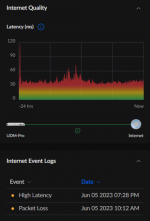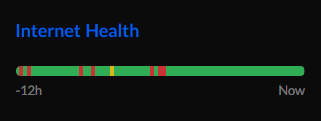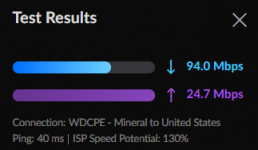Short version; Starlink is finally up and running.
Long version; what a long, strange trip it’s been…
I hired networking company to install my dish on my 12/12 pitch roof, because, well, 12/12.
First trip, he climbed the roof and ran the cell phone app to check for obstructions. We determined 3 trees needed to come down. I took them down and the next week he checked again. Finding no obstructions, he mounted the dish on the roof.
Cost to date: two trips and dish mount $500—yup expensive, but 12/12. Tree removal $300.
Finally got service turned on just over a week ago, and was loosing connection every 2-3 minutes. Checking for obstructions using the actual dish, rather than the app, it showed several small obstructions on the fringes. I was amazed that such limited obstructions would so greatly disrupt service, so often. I was really angry that the phone app didn’t show the obstructions accurately.
I was unwilling to cut any more trees, especially knowing as others grow they would probably become obstructions, so I had to move it off my roof.
Having investigated several options, I found them impossible or far too expensive. The only option left was my pond berm. It’s the only spot on my property that has no obstructions, but it’s 450 feet from the house, far beyond the 100’cable that Starlink says cannot be extended. I needed power at the other side of the lake and a bridge to send the signal back.
I had electric at the house side of the pond for aerators. I ran 380’of 10ga submersible wire to the berm on the other side of the pond. 10ga was used to limit voltage drop over the long distance. After several attempts rowing a johnboat and towing the rope without success, I bought 400 feet of rope and pulled the boat with the rope, while my wife pulled the cable from inside the boat. After lots of sweating and swearing, we got it done. 117 volts at the pond berm, success!
Cost; $1000 for wire, electrical components and rope.
Network company installed today. Took almost 2 hours to remove the dish from the roof and patch the holes, because 12/12. Mounted the dish accross the pond and installed the bridge receiver at the house. Power adapters were mounted in a weatherproof enclosure. Everything went fine until we realized that there was no IP address being delivered. We hooked the bridge to the power block output which worked at first, but we lost the IP. Eventually, we figured out that the modem creates the IP and that we needed to use the ethernet port on the modem instead of the port on the power block. We set up a second bridge receiver at another building using the same bridge transmitter.
Cost; $1100 for bridge and labor
Speeds are typically 40-90 down and 10-14 up with pings 25-80ish. Sometimes lower, a few down speeds as low as 15 and under 1 for up. Not close to what was promised, but 20 times better than what I had, and so far, far more stable and reliable. The bridge does 150 up and down and I was told it would not slow down Starlink since its speeds were lower (we tested it directly)
Total cost $2900. If I had no obstructions cost would have been zero.
Still really angry that the phone app didn’t show the obstructions, but I will eventually get over it.
Having tried all other rural internet options over the last 8 years of living here, Starlink is a godsend, even considering the cost.
Long version; what a long, strange trip it’s been…
I hired networking company to install my dish on my 12/12 pitch roof, because, well, 12/12.
First trip, he climbed the roof and ran the cell phone app to check for obstructions. We determined 3 trees needed to come down. I took them down and the next week he checked again. Finding no obstructions, he mounted the dish on the roof.
Cost to date: two trips and dish mount $500—yup expensive, but 12/12. Tree removal $300.
Finally got service turned on just over a week ago, and was loosing connection every 2-3 minutes. Checking for obstructions using the actual dish, rather than the app, it showed several small obstructions on the fringes. I was amazed that such limited obstructions would so greatly disrupt service, so often. I was really angry that the phone app didn’t show the obstructions accurately.
I was unwilling to cut any more trees, especially knowing as others grow they would probably become obstructions, so I had to move it off my roof.
Having investigated several options, I found them impossible or far too expensive. The only option left was my pond berm. It’s the only spot on my property that has no obstructions, but it’s 450 feet from the house, far beyond the 100’cable that Starlink says cannot be extended. I needed power at the other side of the lake and a bridge to send the signal back.
I had electric at the house side of the pond for aerators. I ran 380’of 10ga submersible wire to the berm on the other side of the pond. 10ga was used to limit voltage drop over the long distance. After several attempts rowing a johnboat and towing the rope without success, I bought 400 feet of rope and pulled the boat with the rope, while my wife pulled the cable from inside the boat. After lots of sweating and swearing, we got it done. 117 volts at the pond berm, success!
Cost; $1000 for wire, electrical components and rope.
Network company installed today. Took almost 2 hours to remove the dish from the roof and patch the holes, because 12/12. Mounted the dish accross the pond and installed the bridge receiver at the house. Power adapters were mounted in a weatherproof enclosure. Everything went fine until we realized that there was no IP address being delivered. We hooked the bridge to the power block output which worked at first, but we lost the IP. Eventually, we figured out that the modem creates the IP and that we needed to use the ethernet port on the modem instead of the port on the power block. We set up a second bridge receiver at another building using the same bridge transmitter.
Cost; $1100 for bridge and labor
Speeds are typically 40-90 down and 10-14 up with pings 25-80ish. Sometimes lower, a few down speeds as low as 15 and under 1 for up. Not close to what was promised, but 20 times better than what I had, and so far, far more stable and reliable. The bridge does 150 up and down and I was told it would not slow down Starlink since its speeds were lower (we tested it directly)
Total cost $2900. If I had no obstructions cost would have been zero.
Still really angry that the phone app didn’t show the obstructions, but I will eventually get over it.
Having tried all other rural internet options over the last 8 years of living here, Starlink is a godsend, even considering the cost.
Last edited:





